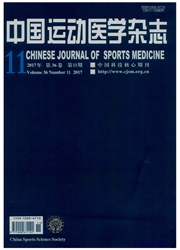

 中文摘要:
中文摘要:
目的:为揭示篮球专项技术的生物力学特点和损伤风险因素、预防膝关节损伤提供依据。方法:以12名篮球专业学生作为实验对象,运用表面肌电遥测和三维摄像技术对行进间突然变向、行进间快速后转身、横切跨步急停起跳和侧切起跳4个技术动作进行同步测试,截取支撑环节作为研究的动作片段。结果:支撑环节包含缓冲制动、支撑碾转和蹬伸离地三个动作阶段或其中两个;臀大肌放电明显且贡献度最大,股前肌群与小腿后肌群的贡献度次之,并因具体动作和性别而异,股后肌群活动相对较弱;支撑环节中,支撑腿膝关节角度均值由大到小排列是侧切上篮、行进间突然变向、行进间快速后转身和横切跨步急停起跳;而角度变化幅度由大到小排列是横切跨步急停、行进间快速后转身、行进间突然变向和侧切起跳。横切跨步急停起跳与行进间快速后转身动作的膝关节最小屈角在90°以下。结果提示:膝关节在半屈曲位发生扭转并快速蹬伸、股后肌群力量弱以及在过小的屈角上快速蹬伸是膝关节损伤的危险因素。建议增强臀大肌、股二头肌力量以及下肢协同肌群、拮抗肌群的配合收缩能力,重视基本功练习和正确技术定型。
 英文摘要:
英文摘要:
Objective To explore the biomechanical characteristics of lower limb during basketball movements in order to understand the risk factors of knee injury. Methods 12 college students majoring in basketball served as the subjects in this experiment. Their three-dimensional video of abrupt turning and rapid turning around during moving,sudden jump shot and lay-ups were recorded,and their surface electromyogram(IEMG)of the supporting leg was collected simultaneously. Results During performing above movements,(1)gluteus maximus contributed maximally in braking and stretching comparing to the gastrocnemius;and lower IEMG amplitude of biceps femoris and semitendinosus was found;(2)the knee angle diminished in turn abrupt turning and rapid turning around,sudden jump shot and lay-ups;and the range ability of the angle decreased gradually from lay-up,to sudden turning,to turning around and to stop jump. The minimum of knee angle during turning around and stop jump shot was less than 90 degrees. Conclusions Rapid torsion and stretch under knee semi-flexion could lead to knee injury,especially when the posterior muscle group of thigh weakened.
 同期刊论文项目
同期刊论文项目
 同项目期刊论文
同项目期刊论文
 期刊信息
期刊信息
